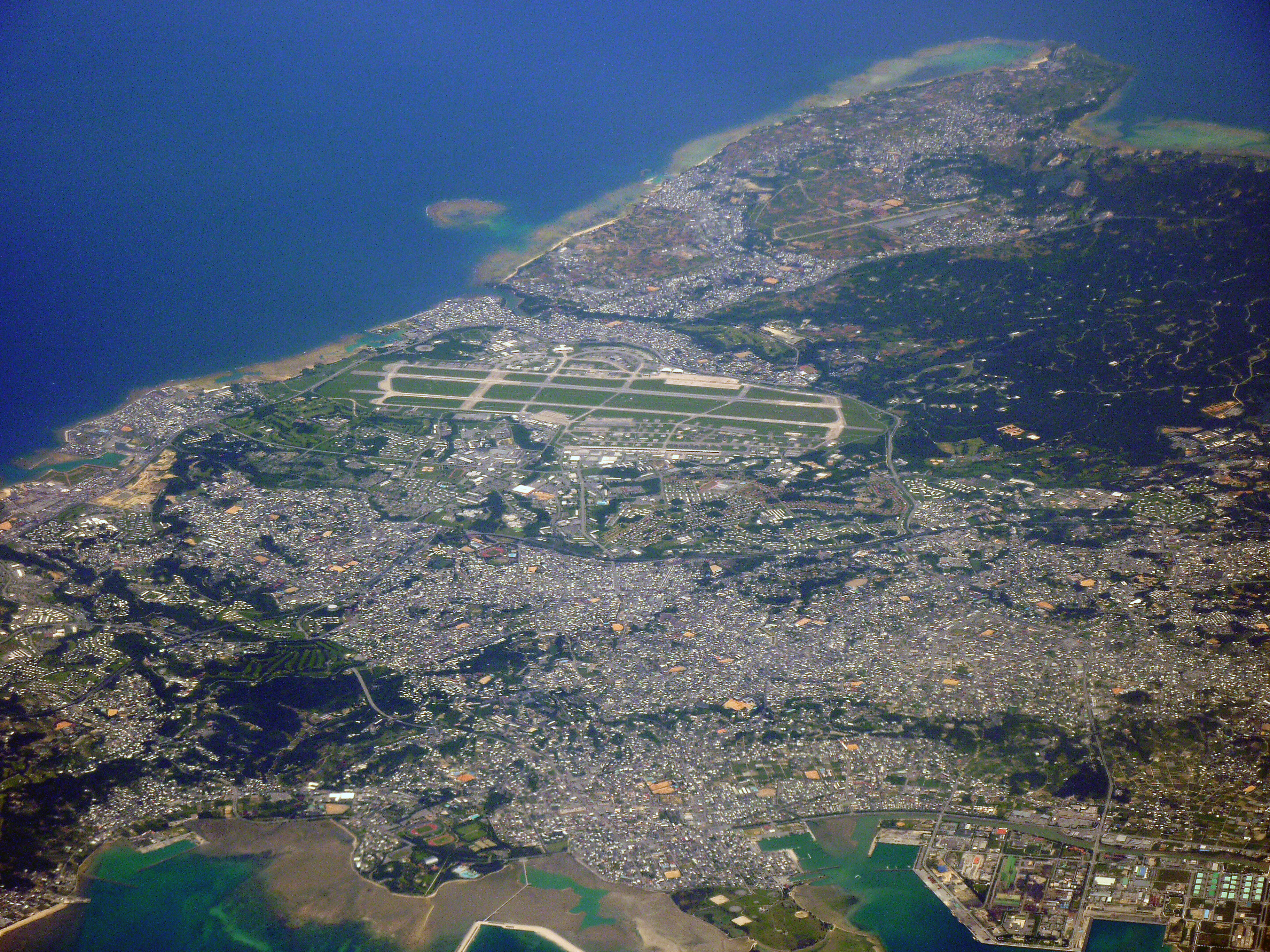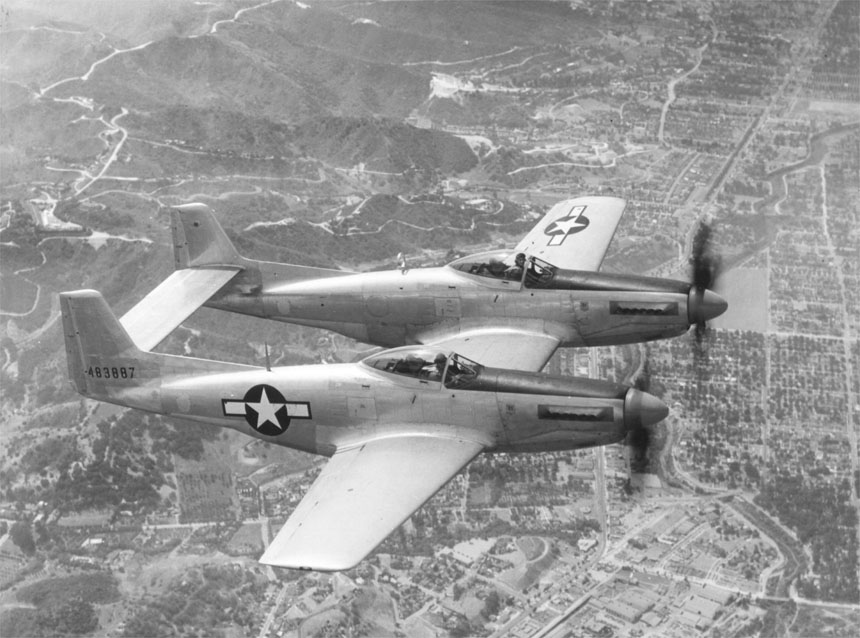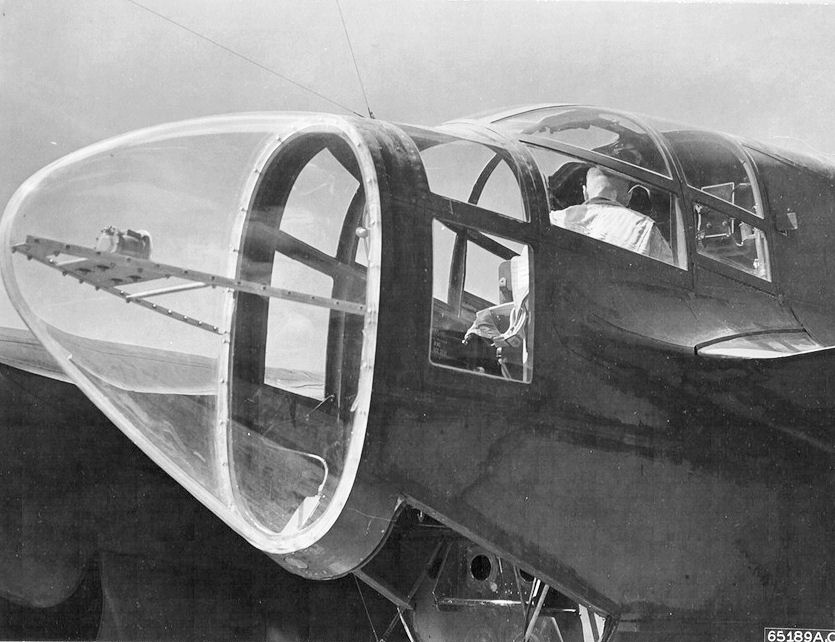|
Naha AFB
, formally known as the , is an air base of the Japan Air Self-Defense Force formerly under control of the United States Air Force. It is located at Naha Airport on the Oroku Peninsula in Naha, Okinawa, Japan. History Imperial Period Naha Airfield was constructed in 1933 as Oroku Naval Air Base, an air base of the Imperial Japanese Navy (IJN). In 1936 control of the air base was transferred to the Japanese Ministry of Communications and formally renamed Naha Airfield. In 1942 control of the air base again reverted to the IJN, which reverted the name of the installation to Oroku Naval Air Base. The facility was captured by the United States during World War II in the Battle of Okinawa on 1 April 1945. US period After World War II the installation became a major United States Air Force (USAF) base under the operational control of Pacific Air Forces (PACAF), and was known as Naha Air Base (Naha AB). The installation became a joint military-civilian air field in 1954 with the resum ... [...More Info...] [...Related Items...] OR: [Wikipedia] [Google] [Baidu] |
Pacific Air Forces
Pacific Air Forces (PACAF) is a Major Command (MAJCOM) of the United States Air Force and is also the air component command of the United States Indo-Pacific Command (USINDOPACOM). PACAF is headquartered at Joint Base Pearl Harbor–Hickam (former Hickam AFB), Hawaii, and is one of two USAF MAJCOMs assigned outside the Continental United States, the other being the United States Air Forces in Europe – Air Forces Africa. Over the past sixty-five plus years, PACAF has been engaged in combat during the Korean and Vietnam Wars and Operations Desert Storm, Southern Watch, Northern Watch, Enduring Freedom and Iraqi Freedom. The mission of Pacific Air Forces is to provide ready air and space power to promote U.S. interests in the Asia-Pacific region during peacetime, through crisis, and in war. PACAF organizes, trains, and equips the 45,000 Total Force personnel of the Regular Air Force, the Air Force Reserve and the Air National Guard with the tools necessary to support the Comman ... [...More Info...] [...Related Items...] OR: [Wikipedia] [Google] [Baidu] |
16th Weapons Squadron
The 16th Weapons Squadron is a United States Air Force unit. It is assigned to the USAF Weapons School, based at Nellis Air Force Base, Nevada. The 16th began as the 16th Pursuit Squadron on 20 November 1940. During World War II, the 16th Squadron flew missions in New Guinea, India, and China in the Curtiss P-40 Warhawk, Republic P-47 Thunderbolt, and North American P-51 Mustang. During the Korean War, the 16th Fighter-Interceptor Squadron flew missions from Korea and Japan in the Lockheed F-80 Shooting Star and North American F-86 Sabre. After the Korean War, the 16th was stationed in Japan, Taiwan, Florida, Norway, Turkey, Korea, and Utah, flying missions in the Convair F-102 Delta Dagger and McDonnell F-4 Phantom II aircraft. In January 1979, the 16th Tactical Fighter Training Squadron became the USAF's first F-16A/B operational squadron. History World War II Activated at Hamilton Field, California in 1941 as a Curtiss P-40 Warhawk pursuit squadron to defend the West Coas ... [...More Info...] [...Related Items...] OR: [Wikipedia] [Google] [Baidu] |
F-86 Sabre
The North American F-86 Sabre, sometimes called the Sabrejet, is a transonic jet fighter aircraft. Produced by North American Aviation, the Sabre is best known as the United States' first swept-wing fighter that could counter the swept-wing Soviet MiG-15 in high-speed dogfights in the skies of the Korean War (1950–1953), fighting some of the earliest jet-to-jet battles in history. Considered one of the best and most important fighter aircraft in that war, the F-86 is also rated highly in comparison with fighters of other eras. Although it was developed in the late 1940s and was outdated by the end of the 1950s, the Sabre proved versatile and adaptable and continued as a front-line fighter in numerous air forces. Its success led to an extended production run of more than 7,800 aircraft between 1949 and 1956, in the United States, Japan, and Italy. In addition, 738 carrier-modified versions were purchased by the US Navy as FJ-2s and -3s. Variants were built in Canada and Austr ... [...More Info...] [...Related Items...] OR: [Wikipedia] [Google] [Baidu] |
F-94 Starfire
The Lockheed F-94 Starfire was a first-generation jet powered all-weather, day/night interceptor of the United States Air Force. A twin-seat craft, it was developed from the Lockheed T-33 Shooting Star trainer in the late 1940s. It reached operational service in May 1950 with Air Defense Command, replacing the piston-engined North American F-82 Twin Mustang in the all-weather interceptor role. The F-94 was the first operational USAF fighter equipped with an afterburner, and first jet-powered all-weather fighter to enter combat during the Korean War in January 1953. It had a relatively brief operational life, being replaced in the mid-1950s by the Northrop F-89 Scorpion and North American F-86D Sabre. The last aircraft left active-duty service in 1958 and Air National Guard service in 1959. Design and development Built to a 1948 USAF specification for a radar-equipped interceptor to replace the aging Northrop F-61 Black Widow and North American F-82 Twin Mustang, it was spe ... [...More Info...] [...Related Items...] OR: [Wikipedia] [Google] [Baidu] |
Korea
Korea ( ko, 한국, or , ) is a peninsular region in East Asia. Since 1945, it has been divided at or near the 38th parallel, with North Korea (Democratic People's Republic of Korea) comprising its northern half and South Korea (Republic of Korea) comprising its southern half. Korea consists of the Korean Peninsula, Jeju Island, and several minor islands near the peninsula. The peninsula is bordered by China to the northwest and Russia to the northeast. It is separated from Japan to the east by the Korea Strait and the Sea of Japan (East Sea). During the first half of the 1st millennium, Korea was divided between three states, Goguryeo, Baekje, and Silla, together known as the Three Kingdoms of Korea. In the second half of the 1st millennium, Silla defeated and conquered Baekje and Goguryeo, leading to the "Unified Silla" period. Meanwhile, Balhae formed in the north, superseding former Goguryeo. Unified Silla eventually collapsed into three separate states due to ... [...More Info...] [...Related Items...] OR: [Wikipedia] [Google] [Baidu] |
Fukuoka Airport
, formerly known as Itazuke Air Base, is an international and domestic airport located east of Hakata Station in Hakata-ku, Fukuoka, Japan. Fukuoka Airport is the principal airport on the island of Kyushu and is the fourth busiest passenger airport in Japan. As of 2017, the airport is the fourth busiest single-runway airport in the world by passenger traffic (after Mumbai, London–Gatwick and İstanbul-Sabiha Gökçen). The airport is surrounded by residential areas; flights stop at 10 p.m. at the request of local residents and resume operation at 7 a.m. The domestic terminal is connected to the city by the Fukuoka City Subway, and a subway from the airport to the business district takes less than ten minutes. The international terminal is only accessible by road, although there is scheduled bus service to Hakata Station and the Tenjin area. Alternatives to access the Fukuoka area include Saga Airport and Kitakyushu Airport. Airlines and destinations Passenger ... [...More Info...] [...Related Items...] OR: [Wikipedia] [Google] [Baidu] |
Twentieth Air Force
The Twentieth Air Force (Air Forces Strategic) (20th AF) is a numbered air force of the United States Air Force Global Strike Command (AFGSC). It is headquartered at Francis E. Warren Air Force Base, Wyoming. 20 AF's primary mission is Intercontinental Ballistic Missile (ICBM) operations. The Twentieth Air Force commander is also the Commander, Task Force 214 (TF 214), which provides alert ICBMs to the United States Strategic Command (USSTRATCOM). Established on 4 April 1944 at Washington D.C, 20 AF was a United States Army Air Forces combat air force deployed to the Pacific Theater of World War II. Operating initially from bases in India and staging through bases in China, 20 AF conducted strategic bombardment of the Japanese Home Islands. It relocated to the Mariana Islands in late 1944, and continued the strategic bombardment campaign against Japan until the Japanese capitulation in August 1945. The 20 AF 509th Composite Group conducted the atomic attacks on Hiroshima and ... [...More Info...] [...Related Items...] OR: [Wikipedia] [Google] [Baidu] |
Kadena Air Base
(IATA: DNA, ICAO: RODN) is a highly strategic United States Air Force base in the towns of Kadena and Chatan and the city of Okinawa, in Okinawa Prefecture, Japan. It is often referred to as the "Keystone of the Pacific" because of its highly strategic and geographic location. It is located just 650 km off the coast of China and at a distance of just 770 km from Shanghai, a major economic hub. It is home to the USAF's 18th Wing, the 353rd Special Operations Group, reconnaissance units, 1st Battalion, 1st Air Defense Artillery Regiment, and a variety of associated units. Over 20,000 American servicemembers, family members, and Japanese employees live or work aboard Kadena Air Base. It is the largest and most active U.S. Air Force base in East Asia. History Kadena Air Base's history dates back to just before the Battle of Okinawa in April 1945, when a local construction firm completed a small airfield named Yara Hikojo near the village of Kadena. The airfield, used by the Im ... [...More Info...] [...Related Items...] OR: [Wikipedia] [Google] [Baidu] |
347th Rescue Group
The United States Air Force's 347th Rescue Group (347 RQG) is an active combat search and rescue unit assigned to the 23rd Wing at Moody Air Force Base, Georgia. : ''For additional lineage and history, see 347th Rescue Wing'' Mission The 347th Rescue Group directs flying and maintenance of the one of two USAF active-duty groups dedicated to combat search and rescue. Responsible for training/readiness of 1,100 personnel, including a pararescue squadron, two flying squadrons (Lockheed HC-130/HH-60 Pave Hawk), and an operations support squadron. Deploys worldwide in support of National Command Authority taskings. Units * 38th Rescue SquadronThe 38th Rescue Squadron trains, equips, and employs combat-ready pararescue and supporting personnel worldwide in support of U.S. national security interests and NASA. This squadron provides survivor contact, treatment, and extraction during combat rescue operations, and uses various fixed/rotary wing insertion/extraction assets and employs ... [...More Info...] [...Related Items...] OR: [Wikipedia] [Google] [Baidu] |
F-82 Twin Mustang
The North American F-82 Twin Mustang is the last American piston-engined fighter ordered into production by the United States Air Force. Based on the North American P-51 Mustang, the F-82 was originally designed as a long-range escort fighter for the Boeing B-29 Superfortress in World War II. The war ended well before the first production units were operational. In the postwar era, Strategic Air Command used the aircraft as a long-range escort fighter. Radar-equipped F-82s were used extensively by the Air Defense Command as replacements for the Northrop P-61 Black Widow as all-weather day/night interceptors. During the Korean War, Japan-based F-82s were among the first USAF aircraft to operate over Korea. The first three North Korean aircraft destroyed by U.S. forces were shot down by F-82s, the first being a North-Korean Yak-11 downed over Gimpo Airfield by the USAF 68th Fighter Squadron. Design and development Initially intended as a very long-range (VLR) escort fighter, ... [...More Info...] [...Related Items...] OR: [Wikipedia] [Google] [Baidu] |
P-61 Black Widow
The Northrop P-61 Black Widow is a twin-engine United States Army Air Forces fighter aircraft of World War II. It was the first operational U.S. warplane designed as a night fighter, and the first aircraft designed specifically as a night fighter. Named for the North American spider ''Latrodectus mactans'', it was an all-metal, twin-engine, twin-boom design armed with four forward-firing 20 mm (.79 in) Hispano M2 autocannon in the lower fuselage, and four M2 Browning machine guns in a dorsal gun turret. Developed during the war, the first test flight was made on May 26, 1942, with the first production aircraft rolling off the assembly line in October 1943. Although not produced in the large numbers of its contemporaries, the Black Widow was operated effectively as a night fighter by United States Army Air Forces squadrons in the European Theater, Pacific Theater, China Burma India Theater, and Mediterranean Theater during World War II. It replaced earlier British-d ... [...More Info...] [...Related Items...] OR: [Wikipedia] [Google] [Baidu] |
4th Fighter Squadron
The 4th Fighter Squadron, "Fighting Fuujins" is part of the 388th Fighter Wing at Hill Air Force Base, Utah. It operates the Lockheed Martin F-35 Lightning II aircraft, which replaced the unit's General Dynamics F-16 Fighting Falcons in August 2017. The 4th FS primarily conducts air superiority, strike, and close air support missions. The squadron was first activated in 1941 as the United States Army Air Corps expanded prior to the entry of the U.S. into World War II. The squadron served in the Mediterranean Theater of Operations, where it earned two Distinguished Unit Citations. The squadron was reactivated in Okinawa as an all-weather fighter squadron in 1947. It served in the air defense of Japan until 1965 as the 4th Fighter-Interceptor Squadron, deploying to fly combat sorties during the Korean War. The squadron returned to the United States in 1965, and reformed as the 4th Tactical Fighter Squadron. In 1969, it moved to Thailand, where it flew missions during the V ... [...More Info...] [...Related Items...] OR: [Wikipedia] [Google] [Baidu] |









